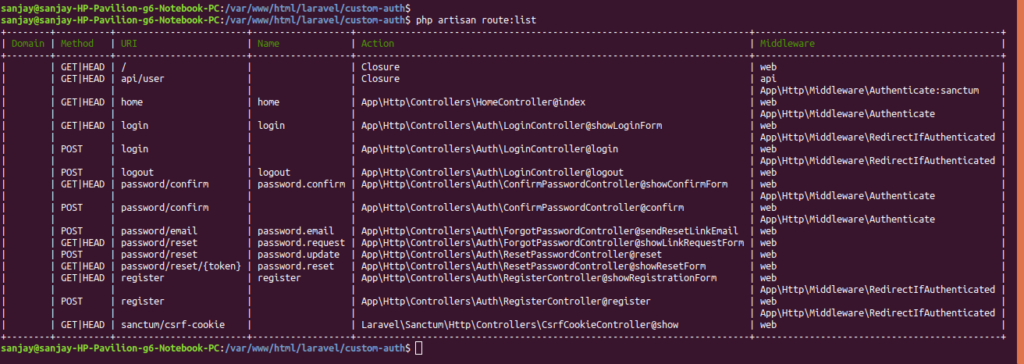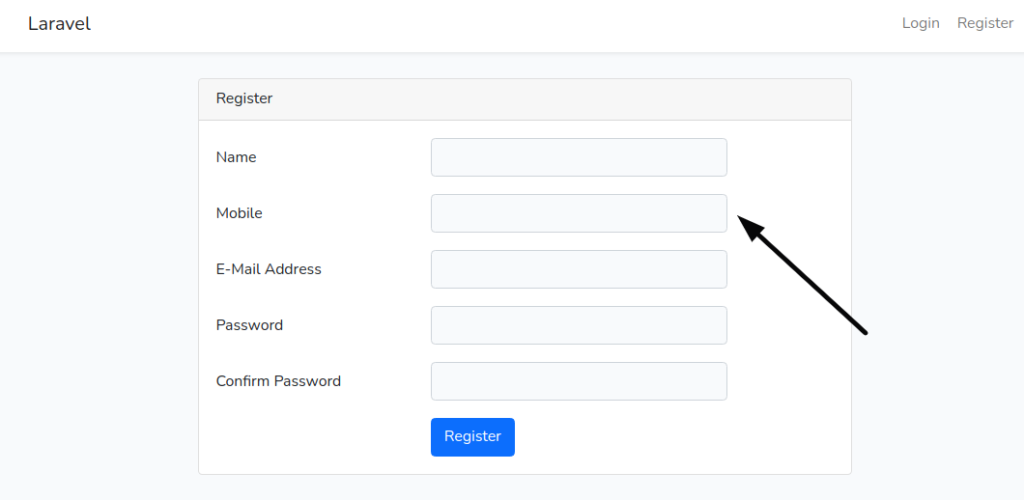Inside this article we will see how to override auth register method in laravel 8 using laravel ui package. laravel ui package provides the simple steps for authentication scaffolding. We will see the step by step process to change register form into a custom registration form of laravel 8 authentication.
If you are looking for an article which gives you the understanding to override the default auth register method then you are at right place to learn.
Laravel authentication via laravel ui package provides the simple steps to override auth register method, login method etc.
Learn More –
- Laravel 8 Authentication using Jetstream with Inertia Js
- Laravel 8 Authentication using Jetstream with Livewire
- Laravel 8 Authentication with Breeze Tutorial
- Laravel 8 Authentication with Laravel UI Tutorial
Let’s get started.
Laravel Installation
We will create laravel project using composer. So, please make sure your system should have composer installed. If not, may be this article will help you to Install composer in system.
Here is the command to create a laravel project-
composer create-project --prefer-dist laravel/laravel blog
To start the development server of Laravel –
php artisan serve
URL: http://127.0.0.1:8000
Assuming laravel already installed inside your system.
Create Database & Connect
To create a database, either we can create via Manual tool of PhpMyadmin or by means of a mysql command.
CREATE DATABASE laravel_app;
To connect database with application, Open .env file from application root. Search for DB_ and update your details.
DB_CONNECTION=mysql DB_HOST=127.0.0.1 DB_PORT=3306 DB_DATABASE=laravel_app DB_USERNAME=root DB_PASSWORD=root
Laravel 8 Authentication with Laravel UI
To learn complete process of laravel authentication with laravel ui package, click here. This will provide you the step by step solution to get into laravel authentication.
Next,
We will see how to change or override auth register method of laravel authentication.
Laravel 8 Authentication Routes
Open project into terminal, if you type this command.
$ php artisan route:list
You will see all hidden routes of laravel authentication

For register auth methods, laravel ui provides these methods
Method for Registration form, showRegistrationForm() from RegisterController.
GET|HEAD | register | register | App\Http\Controllers\Auth\RegisterController@showRegistrationForm.
Method to submit registration form, register() from RegisterController
POST | register | | App\Http\Controllers\Auth\RegisterController@register
To override registration form we need to work on showRegistrationForm() method.
Override Register in Authentication
Open RegisterController.php file from /app/Http/Controllers/Auth folder.
<?php
namespace App\Http\Controllers\Auth;
use App\Http\Controllers\Controller;
use App\Providers\RouteServiceProvider;
use App\Models\User;
use Illuminate\Foundation\Auth\RegistersUsers;
use Illuminate\Support\Facades\Hash;
use Illuminate\Support\Facades\Validator;
class RegisterController extends Controller
{
/*
|--------------------------------------------------------------------------
| Register Controller
|--------------------------------------------------------------------------
|
| This controller handles the registration of new users as well as their
| validation and creation. By default this controller uses a trait to
| provide this functionality without requiring any additional code.
|
*/
use RegistersUsers;
/**
* Where to redirect users after registration.
*
* @var string
*/
protected $redirectTo = RouteServiceProvider::HOME;
/**
* Create a new controller instance.
*
* @return void
*/
public function __construct()
{
$this->middleware('guest');
}
/**
* Get a validator for an incoming registration request.
*
* @param array $data
* @return \Illuminate\Contracts\Validation\Validator
*/
protected function validator(array $data)
{
return Validator::make($data, [
'name' => ['required', 'string', 'max:255'],
'mobile' => ['required', 'max:20'],
'email' => ['required', 'string', 'email', 'max:255', 'unique:users'],
'password' => ['required', 'string', 'min:8', 'confirmed'],
]);
}
/**
* Create a new user instance after a valid registration.
*
* @param array $data
* @return \App\Models\User
*/
protected function create(array $data)
{
return User::create([
'name' => $data['name'],
'mobile' => $data['mobile'],
'email' => $data['email'],
'password' => Hash::make($data['password']),
]);
}
// Custom Register form
public function showRegistrationForm()
{
return view('register');
}
}
We have added a method showRegistrationForm() to override the default auth register page.
Also, we updated validator() method for field validations. Added line –
'mobile' => ['required', 'max:20'],
Update create() method to create a mobile field with post data. Added line –
'mobile' => $data['mobile'],
Next,
We need to define register.blade.php layout file inside /resources/views folder.
Custom Register Blade Template
Create a layout file named as register.blade.php inside /resources/views folder.
Open file and write this complete code into it.
@extends('layouts.app')
@section('content')
<div class="container">
<div class="row justify-content-center">
<div class="col-md-8">
<div class="card">
<div class="card-header">{{ __('Register') }}</div>
<div class="card-body">
<form method="POST" action="{{ route('register') }}">
@csrf
<div class="row mb-3">
<label for="name" class="col-md-4 col-form-label text-md-right">{{ __('Name') }}</label>
<div class="col-md-6">
<input id="name" type="text" class="form-control @error('name') is-invalid @enderror" name="name" value="{{ old('name') }}" required autocomplete="name" autofocus>
@error('name')
<span class="invalid-feedback" role="alert">
<strong>{{ $message }}</strong>
</span>
@enderror
</div>
</div>
<div class="row mb-3">
<label for="mobile" class="col-md-4 col-form-label text-md-right">{{ __('Mobile') }}</label>
<div class="col-md-6">
<input id="mobile" type="text" class="form-control @error('mobile') is-invalid @enderror" name="mobile" value="{{ old('mobile') }}" required autocomplete="mobile" autofocus>
@error('mobile')
<span class="invalid-feedback" role="alert">
<strong>{{ $message }}</strong>
</span>
@enderror
</div>
</div>
<div class="row mb-3">
<label for="email" class="col-md-4 col-form-label text-md-right">{{ __('E-Mail Address') }}</label>
<div class="col-md-6">
<input id="email" type="email" class="form-control @error('email') is-invalid @enderror" name="email" value="{{ old('email') }}" required autocomplete="email">
@error('email')
<span class="invalid-feedback" role="alert">
<strong>{{ $message }}</strong>
</span>
@enderror
</div>
</div>
<div class="row mb-3">
<label for="password" class="col-md-4 col-form-label text-md-right">{{ __('Password') }}</label>
<div class="col-md-6">
<input id="password" type="password" class="form-control @error('password') is-invalid @enderror" name="password" required autocomplete="new-password">
@error('password')
<span class="invalid-feedback" role="alert">
<strong>{{ $message }}</strong>
</span>
@enderror
</div>
</div>
<div class="row mb-3">
<label for="password-confirm" class="col-md-4 col-form-label text-md-right">{{ __('Confirm Password') }}</label>
<div class="col-md-6">
<input id="password-confirm" type="password" class="form-control" name="password_confirmation" required autocomplete="new-password">
</div>
</div>
<div class="row mb-0">
<div class="col-md-6 offset-md-4">
<button type="submit" class="btn btn-primary">
{{ __('Register') }}
</button>
</div>
</div>
</form>
</div>
</div>
</div>
</div>
</div>
@endsection
We have added a mobile number input field into register form.
Update Migration File
Open 2014_10_12_000000_create_users_table.php migration file and add mobile a new column for users table.
Migration file which update the schema of database table.
<?php
use Illuminate\Database\Migrations\Migration;
use Illuminate\Database\Schema\Blueprint;
use Illuminate\Support\Facades\Schema;
class CreateUsersTable extends Migration
{
/**
* Run the migrations.
*
* @return void
*/
public function up()
{
Schema::create('users', function (Blueprint $table) {
$table->id();
$table->string('name');
$table->string('mobile', 20); // New field added
$table->string('email')->unique();
$table->timestamp('email_verified_at')->nullable();
$table->string('password');
$table->rememberToken();
$table->timestamps();
});
}
/**
* Reverse the migrations.
*
* @return void
*/
public function down()
{
Schema::dropIfExists('users');
}
}
Run Migration
Back to terminal and run migrations
$ php artisan migrate OR $ php artisan migrate:refresh
Update User Model
Open User.php from /app/Models folder.
<?php
namespace App\Models;
use Illuminate\Contracts\Auth\MustVerifyEmail;
use Illuminate\Database\Eloquent\Factories\HasFactory;
use Illuminate\Foundation\Auth\User as Authenticatable;
use Illuminate\Notifications\Notifiable;
use Laravel\Sanctum\HasApiTokens;
class User extends Authenticatable
{
use HasApiTokens, HasFactory, Notifiable;
/**
* The attributes that are mass assignable.
*
* @var array<int, string>
*/
protected $fillable = [
'name',
'mobile',
'email',
'password',
];
/**
* The attributes that should be hidden for serialization.
*
* @var array<int, string>
*/
protected $hidden = [
'password',
'remember_token',
];
/**
* The attributes that should be cast.
*
* @var array<string, string>
*/
protected $casts = [
'email_verified_at' => 'datetime',
];
}
Added mobile into $fillable array.
Application Testing
Run this command into project terminal to start development server,
php artisan serveURL: http://127.0.0.1:8000/
Click on Register link of dashboard.

When you provide all data and hit on Register button, it will add a new user to users table.
We hope this article helped you to learn How to Override Auth Register Method in Laravel 8 in a very detailed way.
Online Web Tutor invites you to try Skillshike! Learn CakePHP, Laravel, CodeIgniter, Node Js, MySQL, Authentication, RESTful Web Services, etc into a depth level. Master the Coding Skills to Become an Expert in PHP Web Development. So, Search your favourite course and enroll now.
If you liked this article, then please subscribe to our YouTube Channel for PHP & it’s framework, WordPress, Node Js video tutorials. You can also find us on Twitter and Facebook.
